Leonurus.—Motherwort.
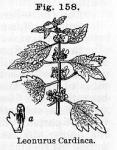
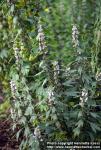 Preparations: Extract of Leonurus
- Compound Pills of Motherwort
Preparations: Extract of Leonurus
- Compound Pills of Motherwort
Related entries: Lycopus
The tops and leaves of Leonurus Cardiaca, Linné.
Nat. Ord.—Labiatae.
COMMON NAME: Motherwort.
Botanical Source.—Leonurus Cardiaca is a perennial plant, with stems from 2 to 5 feet in height, wand-like, minutely downy, acutely quadrangular, with intermediate channels, purplish, beset with numerous pairs of opposite, long-stalked, rough, dark-green, somewhat downy leaves in 4 vertical rows. The lower stem-leaves are palmate-lobed and broadest; the upper ones acutely 3-lobed; those about the summit lanceolate and undivided; and all toothed and cuneiform at the base. The flowers are purplish or whitish-red, in numerous axillary whorls. The calyx is rigid and bristly. Corolla purplish, upper lip clothed with dense, white, shaggy, upright hairs; lower deeply colored, variegated, smooth, in 3 nearly equal entire lobes; middle lobe obcordate. Stamens didynamous; anthers approximated in pairs, with parallel transverse cells and naked valves. sprinkled with shining dots. Achenia oblong, or linear-obovate, blunt and squamosely muricated at the summit, and longitudinally striated, with a long beak; pappus white, hair-like, very soft, simple, and radiated in many rows (L.—W.—G.).
History and Chemical Composition.—Motherwort is an exotic plant, but extensively introduced into this country, growing in fields and pastures, and flowering from May to September. It is supposed to be a native of Tartary, and may probably be indigenous to the northern sections of this country. In some sections of continental Europe, and particulary in Russia Leonurus Cardiaca has been highly endorsed as a remedy for hydrophobia. It has not, however, been as extensively used as a medicinal agent in this country as its virtues warrant. The root sends forth a number of small, long fibers of a dark-yellowish color. The whole plant is medicinal. It has a peculiar, aromatic, not disagreeable odor, and a slightly aromatic, very bitter taste, and yields its properties to water or alcohol. Mr. W. A. H. Naylor (Pharm. Jour. Trans., Vol. XXV, 1894, p. 181) found the following constituents of Leonurus Cardiaca: A bitter principle soluble in alcohol, chloroform, and ether, insoluble in water, benzol, and petroleum ether; an alkaloidal substance, not reacting, however, with Mayer's Solution; a hard resin, a soft resin, fixed oil, wax, and potassium chloride, calcium phosphate, and citric, malic, and tartaric acids. Some interesting notes on the early literature of Leonurus, by E. M. Holmes, precede Mr. Naylor's article.
Action, Medical Uses, and Dosage.—Motherwort is emmenagogue, nervine, antispasmodic, and laxative. It is usually given in warm infusion in amenorrhoea from colds; and in suppressed lochia we have found it superior to any other remedy. Also useful in hysteria and chorea (King). The extract is recommended in nervous complaints, pains peculiar to females, in irritable habits, delirium tremens, typhoid stages, with morbid nervous excitability, all chronic diseases attended with restlessness, wakefulness, disturbed sleep, spinal irritation, and neuralgic pains in the stomach and head, and in liver affections. It is adapted to cases of nervous debility with irritation, nervous unrest, tendency to choreic or spasmodic movements, pelvic and lumbar uneasiness or pain, bearing down pains, and the irritability due to female disorders. Combined with ictodes and resin of black cohosh, it forms a superior antispasmodic, nervine, and emmenagogue. Externally, it maybe used as a fomentation to the bowels in suppressed and painful menstruation, etc. Dose of decoction, from 2 to 4 fluid ounces, every 1, 2, or 3 hours; of the extract, from 3 to 6 grains, every 2 to 4 hours. The root in infusion is diuretic, and is stated to be efficient in obstinate intermittents. The seeds have been given in half-teaspoonful doses in water, in bilious colic, and, it is said, will pass through the bowels when quicksilver will not; they must not be pulverized. This, however, requires more satisfactory evidence (King).
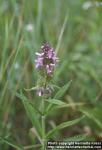 Related Species.—Stachys palustris, Linné, Hedge nettle. Europe and North America, in wet situations. This, with other species of Stachys, has been employed as a topical and general stimulant.
Related Species.—Stachys palustris, Linné, Hedge nettle. Europe and North America, in wet situations. This, with other species of Stachys, has been employed as a topical and general stimulant.
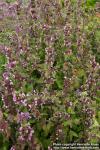 Ballota nigra, Linné, Black horehound.—New England, naturalized. Has been used as a stimulant, antispasmodic, and vermifuge.
Ballota nigra, Linné, Black horehound.—New England, naturalized. Has been used as a stimulant, antispasmodic, and vermifuge.
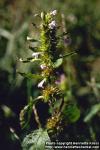 Galeopsis Tetrahit, Linné, Hemp nettle.—Formerly used in bronchitis and intermittent fever.
Galeopsis Tetrahit, Linné, Hemp nettle.—Formerly used in bronchitis and intermittent fever.

